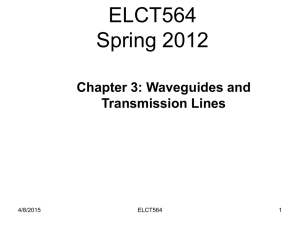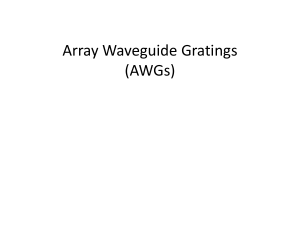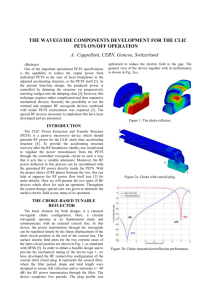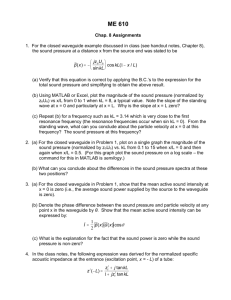RF transport - CERN Accelerator School
advertisement
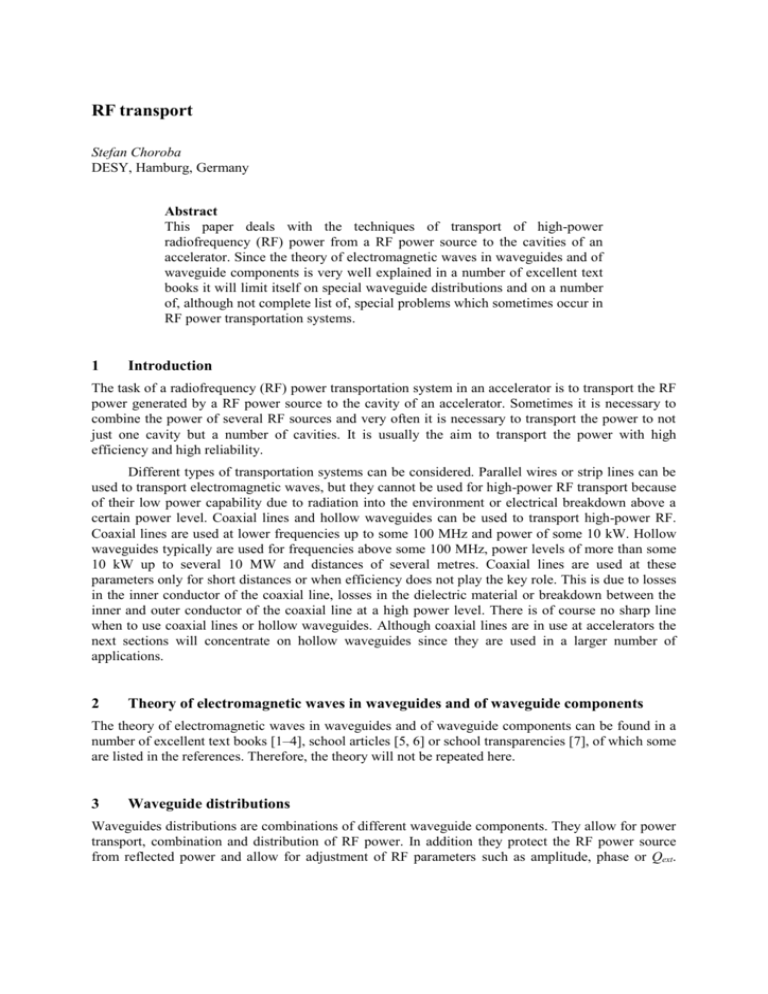
RF transport Stefan Choroba DESY, Hamburg, Germany Abstract This paper deals with the techniques of transport of high-power radiofrequency (RF) power from a RF power source to the cavities of an accelerator. Since the theory of electromagnetic waves in waveguides and of waveguide components is very well explained in a number of excellent text books it will limit itself on special waveguide distributions and on a number of, although not complete list of, special problems which sometimes occur in RF power transportation systems. 1 Introduction The task of a radiofrequency (RF) power transportation system in an accelerator is to transport the RF power generated by a RF power source to the cavity of an accelerator. Sometimes it is necessary to combine the power of several RF sources and very often it is necessary to transport the power to not just one cavity but a number of cavities. It is usually the aim to transport the power with high efficiency and high reliability. Different types of transportation systems can be considered. Parallel wires or strip lines can be used to transport electromagnetic waves, but they cannot be used for high-power RF transport because of their low power capability due to radiation into the environment or electrical breakdown above a certain power level. Coaxial lines and hollow waveguides can be used to transport high-power RF. Coaxial lines are used at lower frequencies up to some 100 MHz and power of some 10 kW. Hollow waveguides typically are used for frequencies above some 100 MHz, power levels of more than some 10 kW up to several 10 MW and distances of several metres. Coaxial lines are used at these parameters only for short distances or when efficiency does not play the key role. This is due to losses in the inner conductor of the coaxial line, losses in the dielectric material or breakdown between the inner and outer conductor of the coaxial line at a high power level. There is of course no sharp line when to use coaxial lines or hollow waveguides. Although coaxial lines are in use at accelerators the next sections will concentrate on hollow waveguides since they are used in a larger number of applications. 2 Theory of electromagnetic waves in waveguides and of waveguide components The theory of electromagnetic waves in waveguides and of waveguide components can be found in a number of excellent text books [1–4], school articles [5, 6] or school transparencies [7], of which some are listed in the references. Therefore, the theory will not be repeated here. 3 Waveguide distributions Waveguides distributions are combinations of different waveguide components. They allow for power transport, combination and distribution of RF power. In addition they protect the RF power source from reflected power and allow for adjustment of RF parameters such as amplitude, phase or Qext. Distributions can be complicated assemblies and sometimes different options exist to fulfil certain requirements. The size of the waveguide is first determined by the RF frequency. It is then still possible to choose between two standard sizes. For the transport of RF power at, for example, 1.3 GHz one can consider WR650 or WR770 waveguides. The decision depends on considerations such as the maximum power to be transmitted, space availability for the installation, weight, cost or availability of waveguide components on the market. Whereas the maximum power demand might require larger size, space demands restrict us to smaller dimensions. The type of distribution system depends on similar considerations. In addition, demands such as the required isolation between cavities (cross-talk), RF parameters to be controlled or adjusted and more requirements must be considered. It is therefore worthwhile to take into account all possible requirements as early as possible and to trade them off. Fig. 1: Principle of a RF power transport system proposed for the TESLA linear collider Figure 1 shows the principle of a waveguide distribution system which has been proposed for the TESLA linear collider. The RF power is generated by a 10 MW high-power klystron and extracted by two output windows towards four accelerator modules with eight superconducting cavities each. In order to achieve a gradient of 23.4 MV/m an input power of 231 kW per cavity is required. The total power produced by the RF power source must take into account losses in the waveguides and a regulation reserve. The power of each klystron waveguide arm is split again by a 3 dB hybrid. For each module a linear distribution system similar to that shown in Fig. 2 is used. Equal amounts of power are branched off for the individual cavities by hybrids with different coupling ratio. Isolators (three port circulators with loads) capable of 400 kW protect the power source from reflected power travelling back from the cavities during the filling time of the cavities or in the case of mismatch or breakdown in the cavities. Three stub tuners or phase shifters can be used for adjustment of phase and Qext. Fig. 2: Linear waveguide distribution system Instead of a linear distribution system a tree-like system can be used (Fig. 3). The power is divided by shunt tees into several branches like the branches of a tree. Fig. 3: Tree-like waveguide distribution system In Fig. 4 examples of distributions meeting the requirements of power distributions for the FLASH facility at DESY are shown. The input power for the distribution can be up to 2.5 MW. Both distributions can be used to meet the requirements but because of certain advantages the first will be used in the future for the European XFEL. The latter and older system is a linear system and is used for the first accelerator modules at FLASH at DESY. The combined system proposed for the European XFEL and in use for the new RF distributions at FLASH makes use of asymmetric shunt tees of different coupling ratios. Equal amounts of power are branched off to a pair of cavities. By adjustment of tuning posts inside the tees the coupling ratios can be adjusted thus changing the branching ratio. The phase between a pair of cavities is pre-tuned by fixed phase shifters (straight waveguides with different waveguide width). The phase for the individual cavities can be adjusted by movable mechanical phase shifters after the symmetric shunt tee which splits the power for two cavities. Isolators in front of each cavity protect the power source from reflected power. This system has several advantages. Space and weight are reduced compared with the linear system. Phasing is much easier than in the purely linear system. Owing to the use of components of similar type the cost can be decreased. This system can also be pre-assembled and connected to an accelerator module before the module is installed in the accelerator tunnel, thus simplifying the entire installation procedure. An accelerator module with RF waveguide distribution can be seen in Fig. 5. Fig. 4: Combined and linear RF waveguide distribution system Fig. 5: Accelerator module and RF waveguide distribution More information on the waveguide distribution systems for TESLA, FLASH and the European XFEL can be found in Refs. [8–12]. 4 Limitations, problems and countermeasures In this section some limitations, problems and possible countermeasures in RF power transportation systems are covered. The power PRF, which can be transmitted in a rectangular waveguide of size a times b in TE10 mode of wavelength is given by 4 E V/cm 2 P RF 6.6310 a cm b cm g with lg = l ælö 1- ç ÷ è 2a ø 2 where E (in V/cm) is the electrical field strength of the electromagnetic wave and g the guide wavelength. The maximum power is the power at the electrical breakdown limit Emax. In air Emax is 30 kV/cm, which results in a RF power of 58 MW at 1.3 GHz in a WR650 waveguide. Experience shows that this power cannot be achieved. In practice, it is 5–10 times lower. The practical power limit is lower because of a variety of different reasons, for example the smaller size of the inner waveguide dimensions (e.g. within circulators), surface effects (roughness, steps at flanges, etc., see Fig. 6), dust in waveguides, humidity of the gas inside the waveguide, reflections (VSWR) or because of higher order modes (HOMs) in TEnm/TMnm. These HOMs can be generated by the power source or by non-linear effects at high power in non-reciprocal devices such as circulators. If these modes are not damped, they can be excited resonantly and reach very high field strength above the breakdown limit. In order to damp HOMs, HOM dampers can be installed. These can be complicated and specially designed devices, which couple out and damp the HOMs only, leaving the fundamental mode, which is transmitted in TE10, untouched. But sometimes a quick solution must be found. This can be accomplished by inserting small antennas at the small side of the waveguides (see Fig. 7). These antennas couple to a number of HOMs in TEnm/TMnm. Since the field of TE10 is already small at the antenna position only a small amount of the power in the fundamental mode is coupled out. The antennas must be connected to loads, which must be able to handle the full amount of the power coupled out. Fig. 6: Waveguide which has been damaged at the flange by breakdown Fig. 7: Waveguide with damping antennas at the small side of the waveguide One could increase the gas pressure inside the waveguide, which due to Paschen’s law would increase the power capability, but this requires enforced and gas tight waveguides. In addition the pressure vessel rules applicable in many countries must be followed. By using SF6 instead of air, which has Emax = 89 kV/cm (at 1 bar, 20°C), the power capability can also be increased. The problem with SF6 is that although it is chemically very stable it is a green house gas and if cracked in sparks it can, together with the hydrogen of the rest amount of water, form HF, which is a very aggressive acid. HF can produce fluorides of the metal of the waveguide walls which one can sometimes find as white powder in the waveguides (see Fig. 8). Other poisonous chemicals, e.g. S2F10, are also produced. Personnel maintaining waveguide components which have been operated in SF6 have to observe a number of safety rules and wear personal protective equipment (see Fig. 9). Fig. 8: Fluorides in a waveguide Fig. 9: Staff wearing protective clothing during work with SF6 waveguides Acknowledgements The author would like to thank two persons who among others supported him during the preparation of this lecture: Valery Katalev provided simulation results and pictures of the waveguide distributions; Ingo Sandvoss took many photographs. References [1] R.E. Collin, Foundations for Microwave Engineering (McGraw-Hill, New York, 1992). [2] D.M. Pozar, Microwave Engineering (Wiley, New York, 2004). [3] N. Marcuvitz, Waveguide Handbook (MIT Radiation Laboratory Series Vol. 10, McGraw-Hill, New York, 1951). [4] H.J. Reich, P.F. Ordung, H.L. Krauss and J.G. Skalnik, Microwave Theory and Techniques (D. van Nostrand, Princeton, NJ, 1953). [5] R.K. Cooper and R.G. Carter, High power RF transmission, Proc. CERN Accelerator School: Radio Frequency Engineering, Seeheim, Germany, 8–16 May 2000. [6] R.K. Cooper, High power RF transmission, Proc. CERN Accelerator School: RF Engineering for Particle Accelerators, Oxford, UK, 3–10 April 1991. [7] A. Nassiri, Microwave Physics and Techniques, USPAS, Santa Barbara, Summer 2003. [8] V. Katalev and S. Choroba, RF power distributing waveguide system for TESLA, Proc. Russian Particle Accelerator Conf., Rupac 2002, Obninsk, Russia, 1–4 October 2002, p. 79. [9] V. Katalev and S. Choroba, Tuning of external Q and phase for the cavities of a superconducting linear accelerator, Proc. XXII International Linear Accelerator Conf., Linac 2004, Lübeck, Germany, 16–20 August 2004, p. 724. [10] V. Katalev and S. Choroba, Compact waveguide distribution with asymmetric shunt tees for the European XFEL, Proc. 22nd Particle Accelerator Conf., PAC07, Albuquerque, NM, 25–29 June 2007, p. 176. [11] S. Choroba et al., Operation experience with the FLASH RF waveguide distribution system at DESY, Proc. XXIV Linear Accelerator Conf., LINAC08, Victoria, BC, Canada, 29 September– 3 October 2008, p. 978 [12] V. Katalev and S. Choroba, Waveguide distribution for FLASH, Proc. Sixth CW and High Average Power RF Workshop, CWRF2010, Barcelona, Spain, 4–7 May 2010, http://cwrf2010.cells.es/





